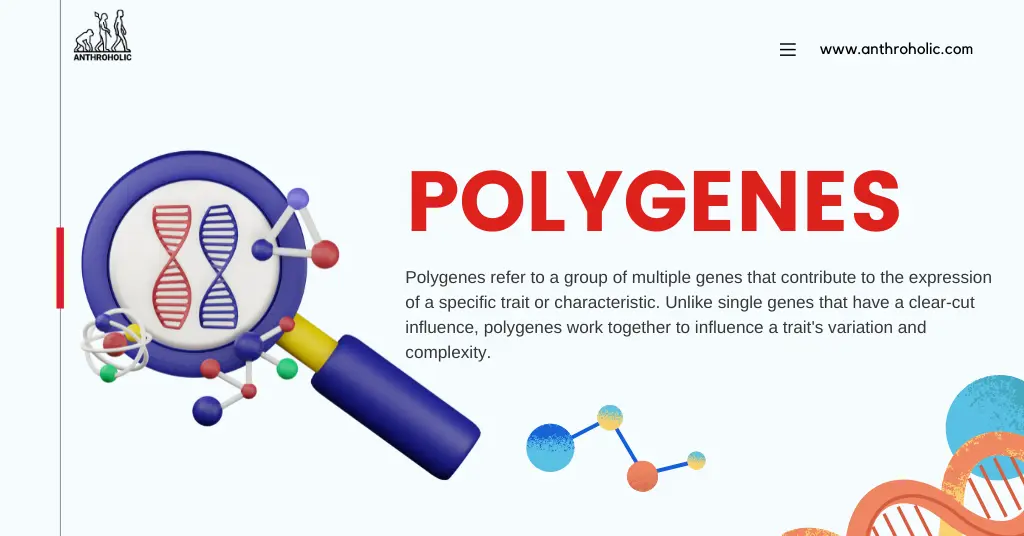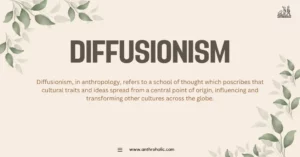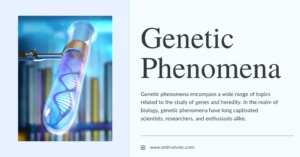AI Answer Evaluation Platform Live Now. Try Free Answer Evaluation Now
Polygenes
Polygenes refer to a group of multiple genes that contribute to the expression of a specific trait or characteristic. Unlike single genes that have a clear-cut influence, polygenes work together to influence a trait’s variation and complexity. Each individual gene has a small effect, but their cumulative impact is significant. Polygenes are responsible for various traits such as height, skin color, intelligence, and susceptibility to diseases. Their interaction with environmental factors makes them challenging to study and understand fully.

Polygenic traits refer to those traits controlled by more than one gene, exhibiting continuous variation. In other words, these traits do not follow simple Mendelian inheritance but are instead the result of many genes interacting together. The British geneticist, R.A. Fisher was instrumental in coining the term ‘polygene’; his work provided the initial foundation to understand the genetic basis of complex traits [1].
The Basics of Polygenic Inheritance
Polygenic inheritance is characterized by the interplay of multiple genes, each contributing a small effect to the overall phenotype. This model of inheritance leads to a continuous range of phenotypes, rather than discrete categories typical in Mendelian inheritance. It’s also critical to note that environmental factors can influence the manifestation of polygenic traits. For instance, even if an individual has genes predisposing them to be tall, factors such as nutrition and exercise can impact their final height.
Historical Overview of Polygenic Studies
The study of polygenic traits has historically been a complex endeavor. Early geneticists focused mainly on traits following simple Mendelian inheritance. It wasn’t until the groundbreaking work by Fisher and Sewall Wright in the early 20th century that we began to understand the genetic architecture of polygenic traits.
With the advent of genomics in the late 20th century, and tools such as Genome-Wide Association Studies (GWAS), researchers could identify multiple genetic loci linked to various polygenic traits [2]. Such advancements have significantly improved our understanding of complex traits and diseases and continue to shape ongoing research in genetics and anthropology.
Exploring the Polygenic Model
The polygenic model of inheritance posits that numerous genes contribute to the phenotype of a single characteristic. Each of these genes potentially contributes a small amount to the overall phenotype, which can lead to a continuum of phenotypic outcomes, such as variations in human height or skin color [3].
One of the hallmarks of the polygenic model is the bell-curve distribution of phenotypes in a population, with most individuals displaying an intermediate phenotype, and fewer individuals exhibiting extreme phenotypes.
Complex Traits and Polygenes
Complex traits, also known as quantitative or polygenic traits, are those determined by the interaction of multiple genes. The genetic influence on these traits doesn’t follow simple Mendelian inheritance patterns. Instead, they display a range of phenotypes along a continuum.
The study of complex traits has been revolutionized by technologies such as Genome-Wide Association Studies (GWAS), which have enabled the identification of numerous genetic loci associated with various complex traits and diseases [2].
The Interplay Between Polygenes and Environment
The polygenic model acknowledges the role of both genetic and environmental factors in shaping an individual’s phenotype. In the case of polygenic traits, while the combined effect of multiple genes can predispose an individual towards a certain phenotype, environmental factors can significantly influence the final outcome.
For instance, nutrition and physical activity can influence body mass index (BMI), a trait that is both heritable and influenced by lifestyle choices. Similarly, exposure to sunlight can affect skin color variation, a well-known polygenic trait.
Anthropological Perspectives on Polygenic Inheritance
Anthropology’s holistic perspective provides a unique lens to study polygenic inheritance. Genetic anthropologists use their understanding of genetics to shed light on human evolution, adaptation, and variation.
The study of polygenic inheritance allows anthropologists to examine how the interaction of numerous genes contributes to phenotypic diversity within and between human populations. For example, polygenic inheritance is key to understanding complex traits like skin color, which shows a vast range of variation across human populations.
Polygenic Traits in Human Evolution
The role of polygenic traits in human evolution is significant. Given that many genes contribute to these traits, they provide a rich substrate for natural selection to act upon.
Some studies suggest that polygenic adaptation, in which natural selection acts on many small-effect genetic variants spread throughout the genome, has been a crucial driver of human evolution. Such adaptations may have allowed early humans to survive and thrive in a diverse array of environments.
The Impact of Polygenes on Human Diversity
Polygenes play a critical role in shaping human diversity. From height and skin color to disease susceptibility, these traits contribute significantly to the variety observed within and across human populations.
However, the interpretation of this genetic diversity must be done with caution. While genetic factors do contribute to phenotypic diversity, it’s important to recognize the significant influence of environmental factors and gene-environment interactions. These considerations are key to a holistic understanding of human diversity.
Case Studies of Polygenic Traits in Human Populations
Research on polygenic traits in human populations provides valuable insights into the genetic basis of human variation and disease susceptibility. This research, combined with environmental data, is also crucial to understanding the multifaceted nature of human biology and health.
Skin Color Variation
Skin color is one of the most visible examples of polygenic inheritance, where multiple genes contribute to the trait’s phenotype. Research has identified several key genes associated with skin pigmentation variation, such as MC1R, SLC24A5, SLC45A2, and OCA2, among others.
This variation is a result of complex interplay between genes and the environment, notably UV radiation, with darker skin providing a protective advantage in regions with high UV radiation, and lighter skin being advantageous in regions with lower UV radiation.
Human Height and Polygenic Influence
Human height is a classic example of a polygenic trait. Numerous genetic loci spread throughout the genome contribute to the determination of an individual’s height.
Despite the strong genetic component, environmental factors such as nutrition, health, and socio-economic status during childhood can have a significant impact on an individual’s final height.
Polygenes and Disease Susceptibility: Diabetes and Heart Disease
Complex diseases like diabetes and heart disease are also polygenic traits. The risk of developing these diseases is influenced by the combined effect of many genes, each contributing a small increase in risk.
For example, in type 2 diabetes, Genome-Wide Association Studies (GWAS) have identified many genetic loci associated with the disease. These studies underscore the polygenic nature of these diseases, and the importance of genetic factors in their onset [4].
Similarly, heart disease is influenced by a large number of genetic variants spread throughout the genome, with each variant only slightly increasing the risk of disease.
Advancements in Genomic Research and Polygenic Traits
Genomic research has greatly advanced our understanding of polygenic traits. Technologies like Genome-Wide Association Studies (GWAS) and Whole Genome Sequencing have enabled the identification of a multitude of genetic loci associated with various polygenic traits and diseases [2].
The development of Polygenic Risk Scores (PRS), which aggregate the effects of many genetic variants across the genome, has furthered our ability to predict an individual’s risk for certain diseases. These advancements have also made it possible to explore the genetic architecture of traits in a way that was previously unimaginable.
Challenges in Studying Polygenic Traits
Despite the advancements, studying polygenic traits presents several challenges. The small effect size of individual genes often requires large study populations to detect associations with statistical significance.
Moreover, the complex interaction between genetic and environmental factors can be difficult to disentangle. This is especially relevant when studying traits that are heavily influenced by environmental factors, such as obesity.
Furthermore, the translation of polygenic research into clinical practice presents its own challenges, such as interpreting and communicating polygenic risk scores to patients.
The Future of Polygenic Research: Prospects and Predictions
Despite these challenges, the future of polygenic research is promising. Advances in genomics, computing, and statistical methods will continue to improve our ability to identify and understand the role of polygenic traits in health and disease.
There is also the potential for personalized medicine, where treatments can be tailored based on an individual’s genetic risk. For example, individuals with a high polygenic risk score for heart disease might benefit from earlier or more aggressive interventions.
The Role of Polygenes in Anthropological Studies
Polygenes have an essential role in anthropological studies, especially in biological or physical anthropology, which investigates human biological diversity across time and space. Polygenic traits are crucial for understanding the genetic basis of complex phenotypes like height, skin color, and disease susceptibility, and their variations within and between human populations.
Studies of polygenic traits also contribute to understanding the evolutionary pressures that have shaped human genetic diversity. For instance, the study of skin color variation has revealed insights into human adaptation to different levels of UV radiation.
Revisiting the Significance of Polygenic Traits in Humanity’s Past, Present, and Future
The study of polygenic traits offers a powerful lens through which to view humanity’s past, present, and future. Polygenic traits can provide clues about our ancestors’ migration and adaptation patterns and inform the current understanding of human health and disease.
Looking forward, with the advent of genomics and other advanced technologies, the study of polygenic traits could help predict future trends in human health, contribute to the development of personalized medicine, and help us grapple with the ethical, legal, and social implications of these advances.
References
[1] Fisher, R. A. (1918). The Correlation Between Relatives on the Supposition of Mendelian Inheritance. Transactions of the Royal Society of Edinburgh, 52(2), 399-433.
[2] Visscher, P. M., Wray, N. R., Zhang, Q., Sklar, P., McCarthy, M. I., Brown, M. A., & Yang, J. (2017). 10 Years of GWAS discovery: biology, function, and translation. The American Journal of Human Genetics, 101(1), 5-22. https://pubmed.ncbi.nlm.nih.gov/28686856/
[3] Miko, I. (2008). Phenotype Variability: Penetrance and Expressivity. Nature Education, 1(1), 137.
[4] Mahajan, A., Go, M. J., Zhang, W., Below, J. E., Gaulton, K. J., Ferreira, T., … & DIAbetes Genetics Replication And Meta-analysis (DIAGRAM) Consortium. (2014). Genome-wide trans-ancestry meta-analysis provides insight into the genetic architecture of type 2 diabetes susceptibility. Nature genetics, 46(3), 234-244. https://www.nature.com/articles/ng.2897




